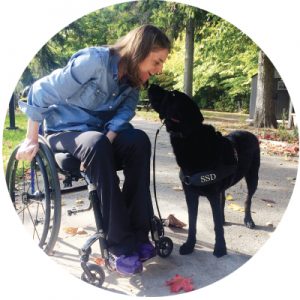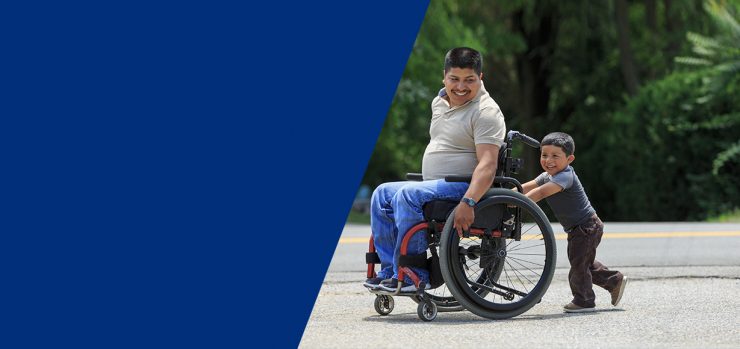Stairs.
Availability of accessible public transport.
Employment opportunities.
The ability to get on the beach to play with your kids.
Being able to open your own front door.
These are just some of the barriers that our community highlighted in our Rolling Through Barriers campaign last year.
When the pandemic hit us in the spring of 2020 the already tenuous and flawed infrastructures and services that support people with disabilities were brought into the spotlight as people’s lives were at stake. Programs that had received band-aid solutions in the past could no longer be patched up anymore. This spurred us to create Rolling Through Barriers as an awareness and fundraising campaign that could shed light on the barriers faced by people in our community and support our efforts to advocate for systemic changes.
The campaign called on people to highlight a barrier that they face, build a physical barrier to represent this issue and video themselves rolling through it. It was a way of bringing attention to the myriad of roadblocks that people with SCI and other disabilities face in an effort to lead a fully inclusive life. While some of these barriers were physical or systemic it was the ones that spoke to attitudinal barriers that resonated the most because of its impact to everyone in our community. The perceptions about life with a disability that our community faces daily are the foundations that other barriers are built upon. It is sometimes these misconceptions that distract from the actual barriers.
“Limits to accessibility are the product of ignorance and naiveté. Our communities have the means to reduce barriers faced by those with disabilities. Indifference and inaction are a choice. By continuing to disseminate this simple truth, I hope it will compel our communities to be better and to do better in the future.”
– Jake Aitcheson
SCIO’s Oda Al-anizi showed us this in his video last year. He challenged public perception by becoming a delivery person for Uber Eats during the campaign. Time after time he was met with surprise when he arrived for his pickups or deliveries. People were not expecting someone using a wheelchair to be delivering their dinner. It made many of them think twice about what someone with a disability could do. However, as Oda challenged their perceptions of what he is capable of, he faced the same accessibility issues he does everyday; stairs, narrow doorways, lack of ramps and curb cuts.
 If the general view of people with disabilities is that they stay at home, then the lack of accessibility in the built environment is not that critical. However, if you consider that your employee or client may have a disability you are more inclined to ensure they do not face unnecessary obstacles. Jake Aitcheson, partner at Lerners Lawyers and one of our Rolling Through Barriers champions last year states “Limits to accessibility are the product of ignorance and naiveté. Our communities have the means to reduce barriers faced by those with disabilities. Indifference and inaction are a choice. By continuing to disseminate this simple truth, I hope it will compel our communities to be better and to do better in the future. Further, while everyone can make valuable contributions, those with disabilities should be the ones that are leading and shaping the discussion. The Rolling Through Barriers campaign was so important to me personally because it provided an opportunity to drive this message across Ontario. “
If the general view of people with disabilities is that they stay at home, then the lack of accessibility in the built environment is not that critical. However, if you consider that your employee or client may have a disability you are more inclined to ensure they do not face unnecessary obstacles. Jake Aitcheson, partner at Lerners Lawyers and one of our Rolling Through Barriers champions last year states “Limits to accessibility are the product of ignorance and naiveté. Our communities have the means to reduce barriers faced by those with disabilities. Indifference and inaction are a choice. By continuing to disseminate this simple truth, I hope it will compel our communities to be better and to do better in the future. Further, while everyone can make valuable contributions, those with disabilities should be the ones that are leading and shaping the discussion. The Rolling Through Barriers campaign was so important to me personally because it provided an opportunity to drive this message across Ontario. “
This year instead of focusing on breaking down physical barriers we want your help in building an accessible future. Rolling Through Barriers aims to provide our community with a chance to share their experiences, their triumphs and the obstacles they continue to face, while striving for a fully inclusive life. With your support, we can impact public policy and legislative change for a more accessible future for everyone, because everyone should have the right to the same access and opportunities.
SCIO is committed to advocating for our community and continues to fight for causes like our Four Urgent Issues:
![]()
Accessible Health Care
![]()
Improved funding models for Mobility Devices
![]()
Access to Medical Supplies
![]()
Accessibility for Ontarians Disability Act Commitment
Our ask is simple.
We want you to share your lived experience in an effort to raise awareness and funds for change.
To show your support, you can share a video contrasting the perceived barriers you face versus the actual barriers you encounter; challenge your friends and families to support and donate to Rolling Through
Barriers or sponsor our event.
Join our movement today: www.rollingthroughbarriers.com






